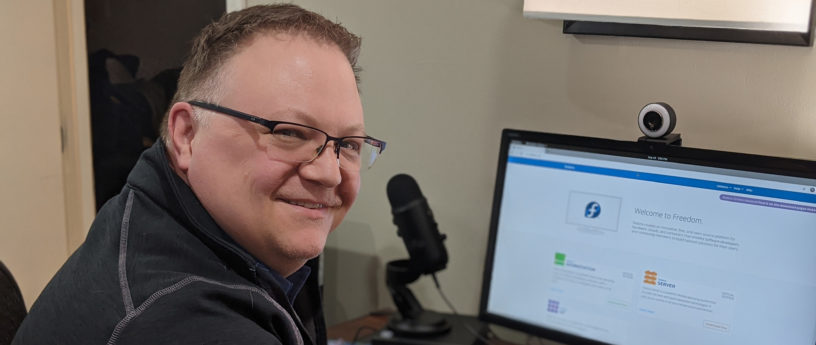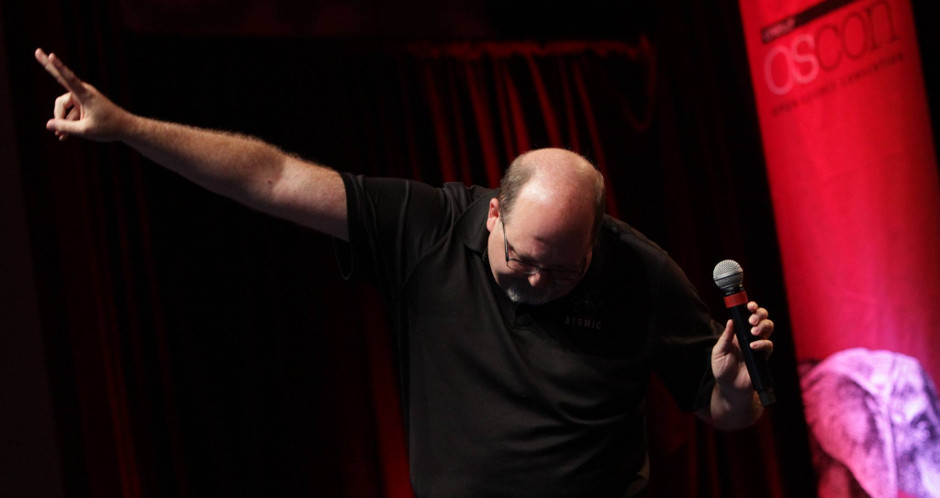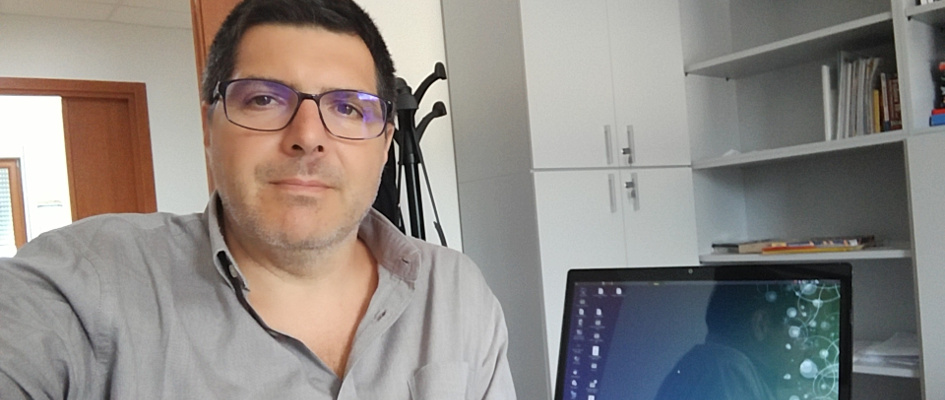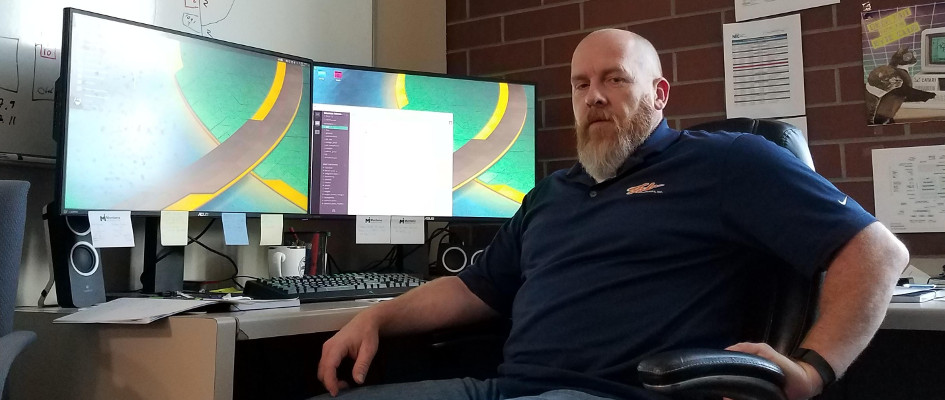We recently interviewed Jim Hall on how he uses Fedora. This is part of a series on the Fedora Magazine. The series profiles Fedora users and how they use Fedora to get things done. Contact us on the feedback form if you are interested in being interviewed for a further installment of this series.
Who is Jim Hall?
Jim Hall served as Chief Information Officer in higher education and government for over eight years and has recently started the consulting company Hallmentum. Most of his work includes training, workshops, and coaching to help new IT leaders develop leadership skills, also to help current IT leaders get better at leadership. Apart from consulting, Jim also serves as adjunct faculty at the university level, currently teaching courses in Management Information Systems (MIS) and Technical & Professional Writing.
How did Jim grow up? Jim’s childhood heroes were from TV and movies, including Batman and Han Solo. Jim’s long-time favorite go-to movie is Star Wars: A New Hope. Jim says, “I am a big Star Wars nerd.” Jim’s favorite meals are Italian. “I love Italian food! Probably my favorite Italian dish is chicken cacciatore.” Jim’s opinion is that Honesty, Creativity, Imagination, Curiosity, and Openness are the five greatest qualities someone can possess.
He loves writing, which is good because most of his day job is about writing. He spends a lot of time writing “how-to” articles for places like OpenSource.com, CloudSavvy IT, and Linux Magazine, and right now he is writing a book about C programming. Apart from writing, he also relaxes by playing video games. He owns a PlayStation 4 and can be found most Saturday afternoons in front of his TV playing a game.
Fedora Community
Jim started using Linux in 1993. His first Linux distribution was Softlanding Linux System (SLS) 1.03, running Linux kernel 0.99 patch level 11. “I’ve been a full-time Linux user at home ever since”. Jim became more involved in Fedora after attending a Linux conference long ago in the Fedora Core days. Jim met Tom “Spot” Callaway there, and they got talking about Fedora. “Spot encouraged me to contribute another way: by finding bugs and reporting them. And that’s how I got involved in testing for all the Beta releases”.
What would Jim like to change in Fedora? He would like to see a countdown on the getfedora.org website, that tells when the new Beta release or new full release is due out as a change in Fedora Project. And Jim wishes that other people know how easy it is to use Fedora. ”The most challenging thing in contributing to open source is to figure out how to make their first contribution.” Jim adds, “I don’t know that I’m a ‘Fedora Project member’ like other developers would be. I’m just a user. But as someone who’s been involved in developing open-source software since 1993 or 1994, I try to be a helpful member of the community. So I take every opportunity to experiment with new Fedora releases, even the Beta releases, and let people know if I find problems.”
What hardware do you use?
Jim is currently running a ThinkCentre M720 Tiny. It’s configured with 8th Generation Intel Core i3-8100T (3.10GHz, 6MB Cache), 32GB (16GB + 16GB) DDR4 2666MHz, Intel graphics, 256GB Solid State Drive PCIe-NVME Opal M.2, Intel 8265 802.11AC, and Bluetooth 4.2. His monitor is an Asus VE248H. “It all works great with Fedora!” says Jim.
He uses the Perixx Periboard-512 Ergonomic Classic Split Keyboard which replaced his original Microsoft Natural Keyboard Elite PS/2 keyboard from 1998. Jim says “I sometimes swap out the Perixx keyboard for my USB clone of the original IBM Model M keyboard, from Unicomp. I do love the clicky keyboard with the buckling spring action. And mine is in the ‘putty white’ color so it has that classic look and feel.”
What software do you use?
Jim is currently running Fedora 33 and previously Fedora 33 Beta, and Fedora 32. “I use GNOME 3 as my desktop. I find the defaults suit most of my needs, so I don’t have any GNOME Extensions loaded, but I do adjust a few things using Settings and GNOME Tweaks. So I’m not making any big changes. For example, I changed my default user interface font to use Droid Sans Regular. And I used Settings to change the keyboard shortcut so Alt-Tab switches windows instead of switching applications. I grew up with the Alt-Tab workflow, so I’m used to that,” says Jim. He uses Firefox and Google Chrome as his web browsers.
To run his consultancy business, Jim relies on a suite of applications:
- LibreOffice to write his books. For example, he published Coaching Buttons last year. He wrote this book entirely using LibreOffice. More recently, he wrote a book about Writing Free DOS Programs in C and used LibreOffice for that too.
- INKSCAPE for creating his company logo in vector format. His logo scales up and down perfectly—from a small corner image on a document to a large-format poster or banner. And INKSCAPE lets him export to a variety of common formats. Jim says that his advertising partners appreciate that INKSCAPE can export to EPS (Encapsulated Postscript), which makes it a snap to print his logo on products.
- GIMP for other graphics, such as a splash image. “My splash image is my company logo placed over a background image, and I use that in place of a plain logo where I need extra pizzazz, such as on printed materials. I also use a version of the splash image on my website.”
- QEMU to run a virtual machine where he can boot FreeDOS. “I like using QEMU because I can set all the options I need at the command line, which gives me a lot of extra flexibility in configuring the virtual machine. To make this easier, I put all the options into a script, and use that to run QEMU with the same options every time.”
- Scribus to print products. Scribus is easy to use to create print-ready materials with full bleed, meaning any color backgrounds overlap the edge of the paper. Full bleed requires a special print-ready file that overlaps the print area . It even provides cut marks so that the printer knows exactly where to trim.













































rugk
“Don’t get nibbled to death by ducks”? 🤣
Roger
I checked out the font ‘droid sans regular’ for the user interface…I like it.
Anise Star
Try Red Hat Display
Roger
Very good too, thank you.
Michael
What is manufacturer of the microphone in the background?
Grayson / computerkid
Looks like a blue yeti to me
Jim Hall
Correct, that is a Blue Yeti microphone. Great sound quality.
Helmy
I think that is rhode
Gregory Zeng
Why was the Deb package manager avoided? RPM seems not so popular with 3rd party application creators, such as Flashpeak Slimjet. Even Red Hat seems to not prefer Fedora.
Julius Schwartzenberg
Jim, have you considered running FreeDOS inside DOSEMU2 instead of QEMU?
Recently work was done specifically to provide FreeDOS also easily to DOSEMU2 users on Fedora:
https://github.com/dosemu2/dosemu2/wiki/Download-sites-for-dosemu2